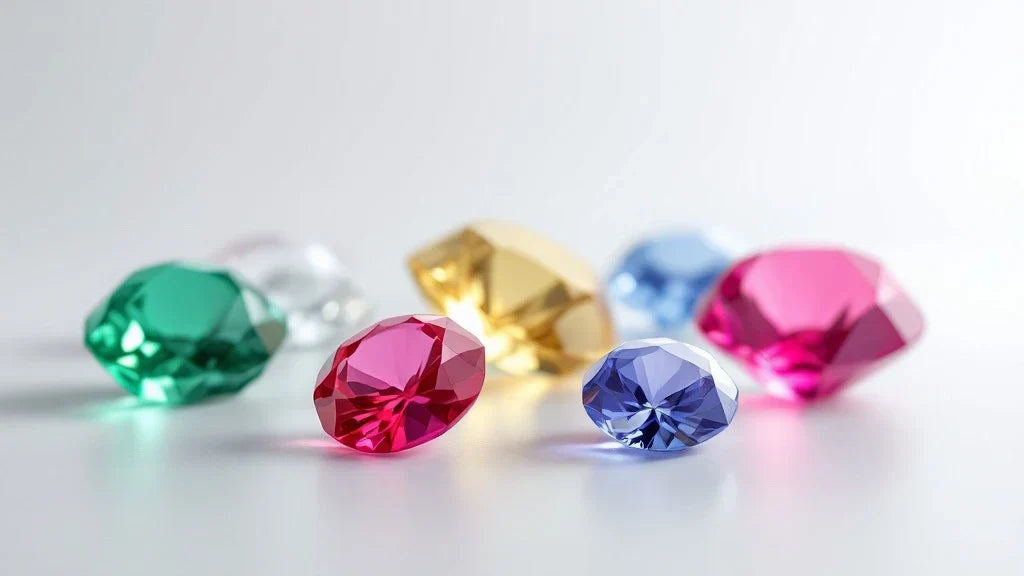
What Are Lab-Grown Gemstones? A Complete Guide
Share
Lab-grown gemstones are becoming a preferred choice for jewellery buyers due to their affordability, ethical sourcing, and quality. These gemstones are created in laboratories using advanced technology to replicate natural gem formation, resulting in stones that are visually, chemically, and physically identical to their mined counterparts.
Jump to Section
- What Are Lab-Grown Gemstones?
- How Are Lab-Grown Gemstones Made?
- Lab-Grown vs. Natural Gemstones
- Ethical & Environmental Benefits
- Consumer Perceptions & Market Trends
- Pricing & Production Timeline
- Certification & Buying Considerations
- Common Myths & FAQs
- Conclusion
What Are Lab-Grown Gemstones?
Lab-grown gemstones are real gemstones with the same chemical, physical, and optical properties as natural gemstones. They are grown in controlled laboratory environments rather than mined from the Earth. Unlike synthetic or simulated stones, they are indistinguishable from natural gemstones except under specialized gemological equipment.
How Are Lab-Grown Gemstones Made?
Different gemstones require specific processes that mimic their natural formation.
| Method | Process | Used For |
|---|---|---|
| HPHT (High Pressure High Temperature) | Mimics Earth's deep pressure and heat to grow diamonds. | Lab-grown diamonds |
| CVD (Chemical Vapor Deposition) | Carbon gas is used to grow diamond layers. | High-quality lab diamonds |
| Flame Fusion | Powdered minerals melted and crystallized. | Sapphires, rubies |
| Hydrothermal Growth | High-pressure water solution grows crystals over time. | Emeralds, quartz |
Lab-Grown vs. Natural Gemstones
| Feature | Lab-Grown Gemstones | Natural Gemstones |
|---|---|---|
| Formation | Created in controlled lab environments | Formed naturally over millions of years |
| Clarity & Inclusions | Fewer inclusions, more consistent quality | Can have unique inclusions |
| Cost | Typically 30-40% cheaper | Higher prices due to rarity |
| Sustainability | Environmentally friendly, conflict-free | Mining can have environmental and ethical concerns |
Ethical & Environmental Benefits
- Reduced Land Disruption: No large-scale excavation or deforestation.
- Lower Carbon Emissions: Lab production has lower emissions than traditional mining.
- Conflict-Free Sourcing: No ties to unethical mining or exploitative labor practices.
Consumer Perceptions & Market Trends
- 80% of consumers are now aware of lab-grown diamonds (2023 Jewelers Board of Trade survey).
- More buyers prefer lab-grown stones due to affordability and ethical considerations.
- Online sales are increasing, with lab-grown diamonds making up a growing portion of e-commerce jewellery sales.
Pricing & Production Timeline
Lab-grown gemstones typically cost 30-40% less than their mined counterparts. The affordability is due to a more controlled supply chain and the elimination of mining costs. However, they may not hold resale value as well as natural gemstones.
Certification & Buying Considerations
- IGI (International Gemological Institute) and GIA (Gemological Institute of America) are the most recognized certifiers.
- Certifications verify the quality, origin, and authenticity of the gemstone.
- Transparency in disclosure is key—always verify that a stone is labeled as lab-grown.
Common Myths & FAQs
Are Lab-Grown Gemstones Fake?
No, they are chemically identical to natural gemstones and are not imitations.
Can a Jeweler Tell If a Stone Is Lab-Created?
Most jewelers cannot distinguish them without specialized gemological equipment.
Do Lab-Grown Stones Hold Their Value?
Lab-grown gemstones are more affordable but typically do not retain resale value like mined stones.
What Are the Disadvantages of Lab-Grown Diamonds?
They do not hold resale value as well as natural diamonds, and some consumers prefer the rarity of mined stones.
Are Lab-Grown Emeralds as Durable as Natural Emeralds?
Yes, lab-grown emeralds have the same hardness and durability but may have fewer inclusions.
How Do Lab-Grown Gemstones Impact the Jewellery Industry?
Lab-grown gemstones are reshaping the industry by offering ethical, high-quality, and affordable alternatives to natural stones.
Conclusion
Lab-grown gemstones offer a compelling alternative to mined stones, providing the same beauty, durability, and brilliance at a more accessible price point. They are an ethical, sustainable, and increasingly popular choice among consumers. Whether for engagement rings or fine jewellery, lab-grown gemstones represent the future of the industry.
